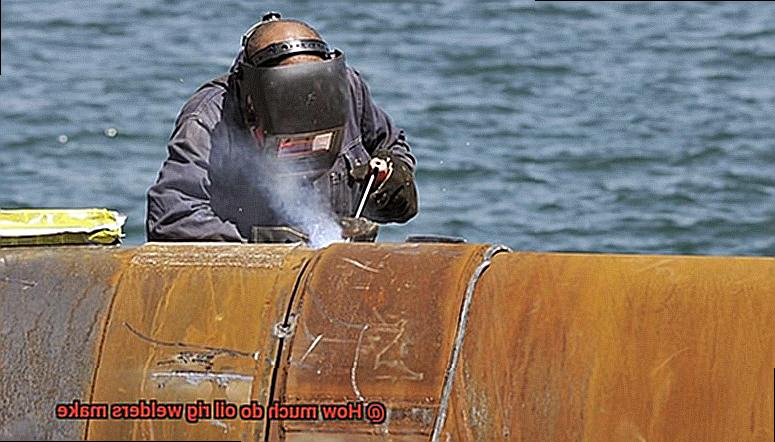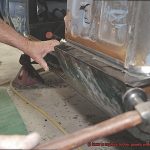Have you ever pondered the earning potential of oil rig welders?
Whether you’re considering a career in this field or simply curious about their salaries, you’ll find this information both intriguing and enlightening. Welding is an indispensable aspect of the oil rig industry, and skilled welders are in high demand.
But what exactly is their earning potential? Oil rig welders earn a remarkable salary compared to other blue-collar workers.
These professionals undergo extensive training to master specialized techniques involved in welding, rigging, and equipment maintenance. With such high demand for these skills, it’s no surprise that oil rig welders can earn anywhere between $70,000 to $100,000 annually.
However, wages aren’t the only factor that draws welders towards the oil rig industry. They also have an opportunity to work in a unique and exhilarating environment – often on offshore locations surrounded by breathtaking views of the ocean.
Welding is one of the most critical jobs in the oil rig industry, requiring significant responsibility and skill. So whether you’re interested in pursuing a career as a welder or simply want to know more about how much these skilled professionals earn – keep reading.
In this blog post, we will delve into the details of how much oil rig welders make, what factors affect their salary, and what qualifications are needed to become one.
Average Salary of an Oil Rig Welder
Contents [show]
It’s no secret that this specialized field can be financially rewarding, but let’s take a closer look at what factors can impact an oil rig welder’s average salary.
Firstly, it’s important to keep in mind that oil rig welding is a physically demanding job that requires extensive training and experience. However, this specialized knowledge also means that oil rig welders are highly valued and can earn higher wages than the average worker.
According to data from the Bureau of Labor Statistics, the median pay for a welder, cutter, or solderer in 2020 was $44,190 per year or $21.24 per hour. On the other hand, the typical hourly rate for an oil rig welder ranges from $25 to $40 per hour, with experienced workers earning upwards of $120,000 per year.
Location is another key factor that can impact an oil rig welder’s salary. For example, in Texas – where there is a high demand for oil rig workers – the average hourly wage for an oil rig welder ranges from $26 to $36 per hour.
Other states may offer lower salaries due to less demand for this specialized skillset. Additionally, whether you work as a contract worker or permanent employee can also affect your salary.
Contract workers generally earn more money than permanent employees due to the short-term nature of their employment. The average monthly salary for a contract oil rig welder is around $10,000 to $15,000 per month.
It’s worth noting that oil rig welding is a challenging job that often requires long hours and working in hazardous conditions. However, many employers offer additional compensation such as hazard pay or overtime pay to help offset these difficulties.
Some companies may also provide other benefits such as healthcare and retirement plans. In conclusion, becoming an oil rig welder can be a lucrative career choice for those interested in this challenging field.
Factors That Affect the Pay Rate of an Oil Rig Welder
The first and foremost factor is experience.
As with any job, those who have been in the field longer and have more experience will generally earn more than rookies. This is because experienced welders are typically more efficient and can save companies valuable time and money.
The location of the oil rig can also impact an oil rig welder’s pay rate. Welders who work on rigs in remote or dangerous locations may be paid more than those working on rigs closer to urban areas or in less hazardous environments.
This is because working in these conditions may require longer hours or more challenging work, which can increase earning potential. Moreover, the type of welding being performed can also impact an oil rig welder’s pay rate.
Certain types of welding, such as underwater welding or specialized welding techniques, may require additional training or certification, increasing earning potential. Additionally, some types of welding may be more in demand than others, leading to higher wages for those skilled in those areas.
It’s clear that there are many factors that can influence an oil rig welder’s pay rate. But, by working to develop their skills and gain experience in the field, oil rig welders can increase their earning potential and enjoy a fulfilling and rewarding career.
If you’re considering a career as an oil rig welder, keep these factors in mind as you work towards success in this challenging but lucrative profession.
Types of Employment for Oil Rig Welders
There are four types of employment for oil rig welders to choose from: full-time, part-time, contract, and freelance. Full-time employees work for a single employer and receive a steady salary or hourly wage with benefits such as health insurance, retirement plans, and paid time off.
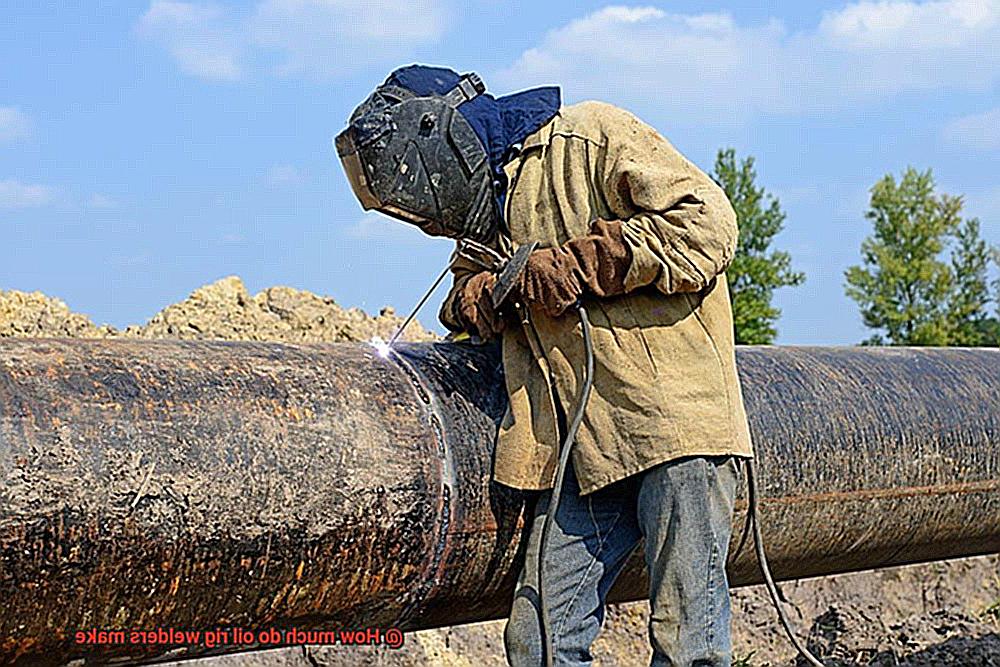
Part-time employees work fewer hours and may not receive the same level of benefits as their full-time counterparts. Contract oil rig welders, on the other hand, work for a specific period, usually on a project-by-project basis.
They are hired by a company or contractor to perform a specific job and are paid a predetermined rate based on their skills and experience. Freelance oil rig welders work independently and are responsible for finding their own clients and negotiating their own rates.
It’s important to consider that the type of employment an oil rig welder chooses can greatly affect their earning potential. While full-time employees typically have more stability and benefits, contract and freelance workers may have higher earning potential but less job security.
Before launching your career in the oil rig welding industry, it’s crucial to carefully weigh your options and choose the type of employment that aligns with your needs and goals.
Highest Paid Welding Jobs
This skilled trade requires specialized training and expertise, but the rewards can be significant. In this article, we’ll explore the five highest paid welding jobs and the associated salaries.
At the top of the list are oil rig welders, who can earn an average salary of around $62,000 per year. However, in some cases, these professionals can make upwards of $100,000 per year.
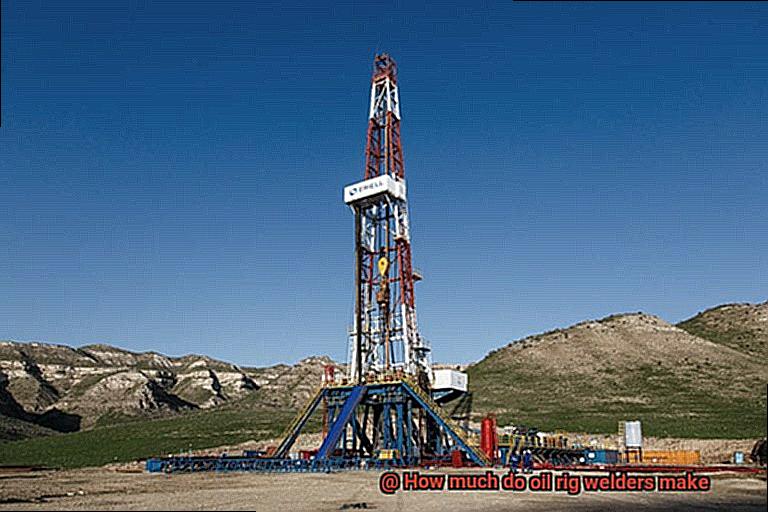
The hazardous nature of their work and need for specialized skills make them highly sought after in the oil and gas industry. Pipeline welders are also among the highest paid welding jobs.
These professionals specialize in welding pipes that transport oil and gas and can earn an average salary of around $66,000 per year. With a growing demand for pipeline infrastructure, pipeline welders are in high demand.
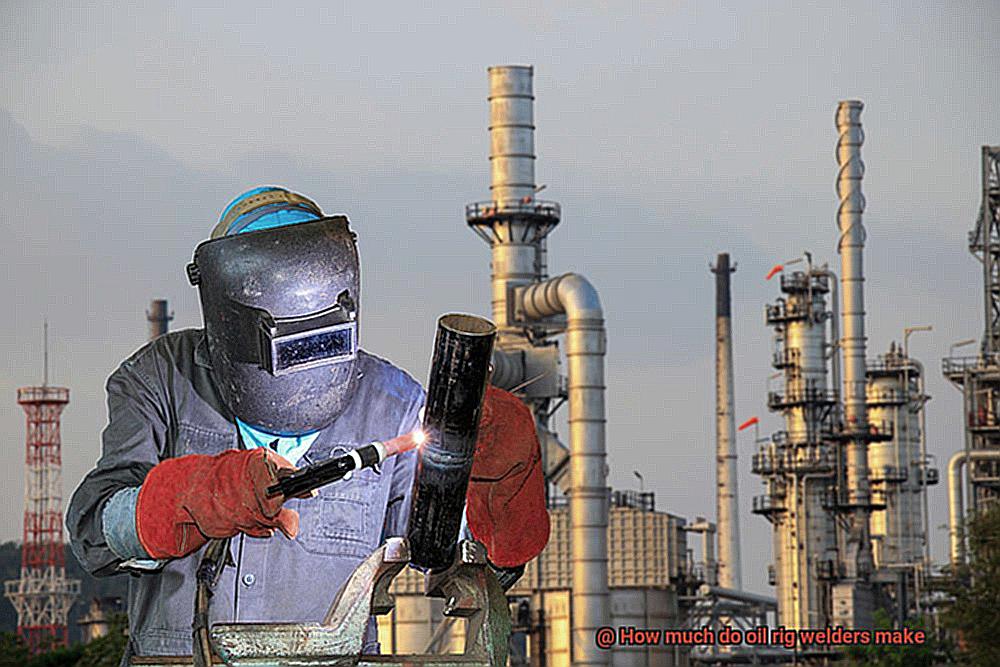
Underwater welders are another highly sought after group with significant earning potential. The dangerous nature of their work means they can earn an average salary of around $53,000 per year.
However, experienced professionals can make over $200,000 per year. If you’re comfortable working underwater and have the right skills, this could be the perfect career path for you.
In addition to these three top-paying welding jobs, there are other high-paid opportunities available as well. For example, aerospace welders who work on airplanes and spacecraft can earn an average salary of around $55,000 per year.
Meanwhile, senior welding engineers can make an average salary of around $102,000 per year. While welding jobs can be physically demanding and sometimes dangerous, they offer excellent earning potential for those with the right skills and experience.
Most In-Demand Welding Types
After extensive research, I have discovered that MIG, TIG, Stick, Flux-Cored, and Submerged Arc Welding (SAW) are the top five most sought-after types of welding in the industry. MIG welding is the jack-of-all-trades in the welding world.
It’s highly versatile and easy to learn, making it a popular choice for manufacturing, construction, and automotive industries. With MIG welding, you can produce high-quality welds that are both strong and aesthetically pleasing.
TIG welding, on the other hand, requires a high level of skill and precision. This complex process is used to weld thin materials like aluminum and stainless steel.
TIG welders are highly valued for their ability to produce clean and precise welds without any spatter or distortion. Stick welding is known for its strength and durability.
This heavy-duty process is often used in construction and pipeline applications where welds need to withstand harsh environments. Stick welding produces deep penetration welds that are highly resilient to wear and tear.
Flux-Cored welding uses a flux-cored wire instead of a solid wire. This type of welding is highly efficient and quick, making it popular in shipbuilding, construction, and metal fabrication industries.
With Flux-Cored welding, you can produce high-quality welds with minimal preparation time. Submerged Arc Welding (SAW) is a specialized process used for thick materials like pipes and tanks.
SAW welding uses a flux to shield the arc from the atmosphere while producing deep penetration welds quickly and efficiently. SAW welders are highly valued for their expertise in this complex process.
Ultimately, choosing the right type of welding for your career goals requires careful consideration.
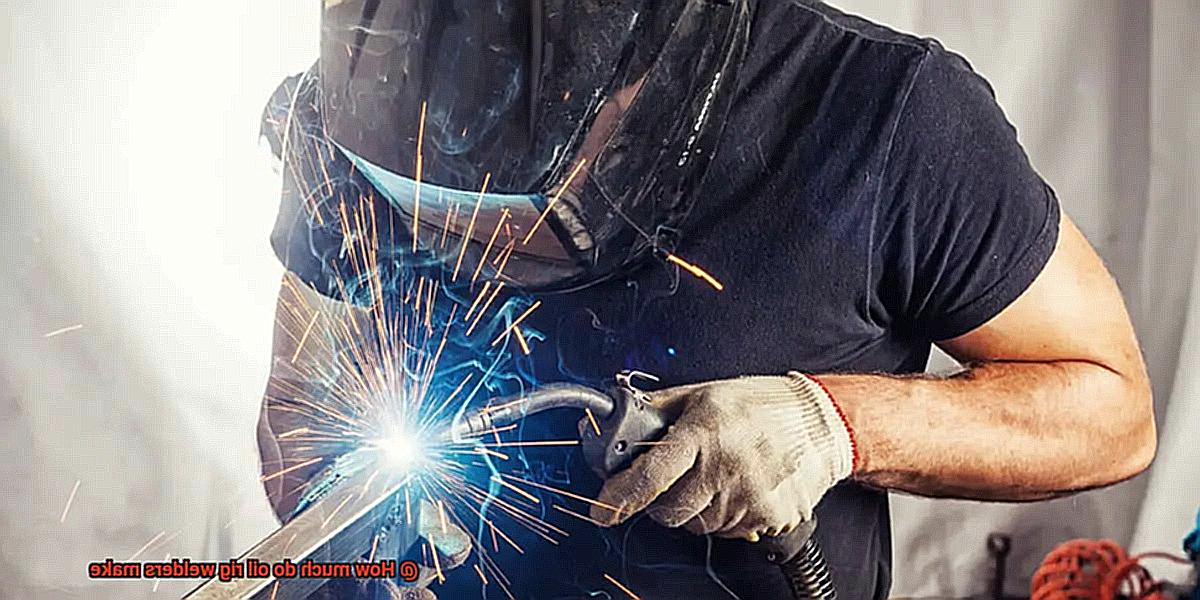
However, with specialized training and expertise in MIG, TIG, Stick, Flux-Cored, or Submerged Arc Welding (SAW), you could earn a salary upwards of $100,000 per year due to the high demand in these fields.
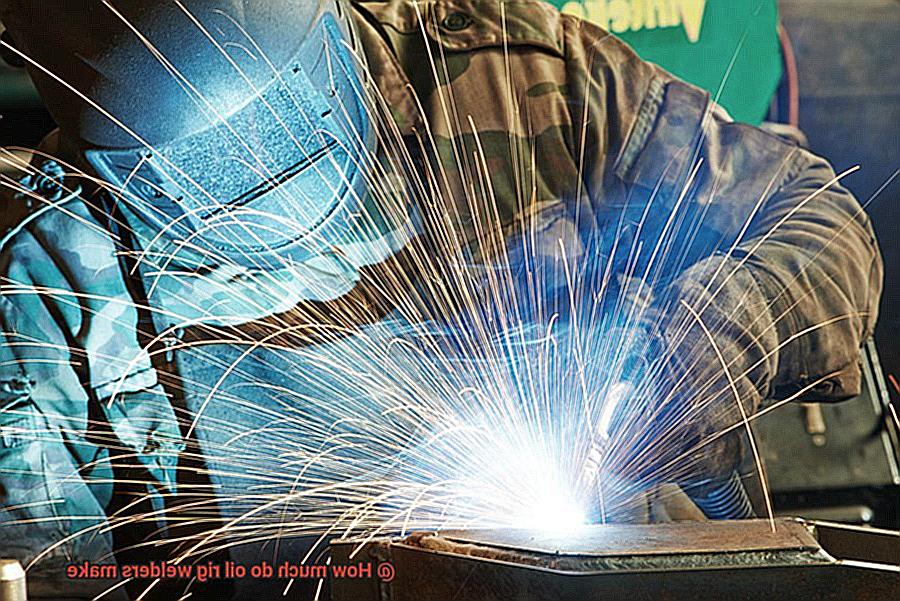
Can Welders Make $100,000?
The answer is a resounding yes.
Welding is a highly sought-after profession, and with the right skills and experience, welders can earn a six-figure income. However, it’s important to note that this salary is not typical for all welders.
Location plays a crucial role in determining a welder’s earning potential. Welders working in industries with high demand, such as oil rigs or aerospace, are likely to earn more than those in construction or manufacturing.
Therefore, if you’re willing to relocate to maximize your earning potential, you may be able to earn $100,000 or more per year. Education and training are other essential factors that can impact a welder’s earning potential.
Those who have completed an apprenticeship or earned a degree in welding are highly skilled and in-demand in the job market. Consequently, they often command higher salaries than those without formal training.
Moreover, specialization in a specific type of welding can also influence your earning potential. Some types of welding require specialized knowledge and skill sets that are in high demand.
If you specialize in these fields, you may be able to command higher salaries compared to those who don’t have the same level of expertise. Finally, your willingness to work long hours or travel for work can also affect your earnings as a welder.
Projects that require extensive travel or overtime hours may pay more. So, if you’re willing to put in the extra effort and time needed to complete projects on time, you may be able to earn more money.
Welding is not only a lucrative career but also offers creative fulfillment for those who enjoy working with their hands.
Conclusion
In summary, oil rig welding is a highly skilled and physically demanding job that can provide excellent earning potential.
Depending on factors such as experience, location, type of welding being performed, and employment type, oil rig welders can earn anywhere from $70,000 to $120,000 annually. The hazardous nature of the job and the need for specialized skills make oil rig welders highly sought after in the oil and gas industry.
Welding offers not only financial rewards but also creative fulfillment for those who enjoy working with their hands. If you’re considering a career in welding or specifically as an oil rig welder, it’s important to carefully consider your options and choose the employment type that aligns with your needs and goals.
With specialized training in MIG, TIG, Stick, Flux-Cored or Submerged Arc Welding (SAW), you could potentially earn a salary upwards of $100,000 per year due to high demand in these fields.
